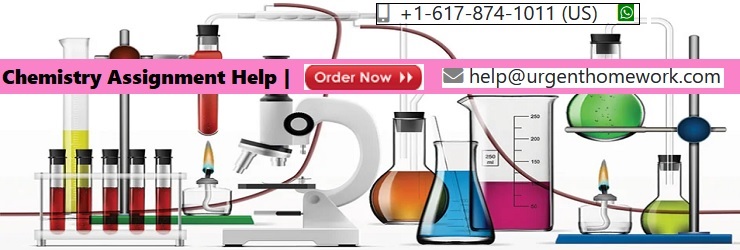Chemistry Homework Help

Get Professional Chemistry Homework Help Services from Experts
Urgenthomework provides Homework Help in Chemistry. Chemistry, the study of matter is one of the most complex of all subjects and needs deep and thorough understanding and hours of deep concentration and study to master it. It can not be understood by just reading and needs skillful explanation to make the grasping easier. Though it is a Science but it has a lot of application in everyday life too. Chemistry Tutors are not found easily as the subject can not be understood by all with ease. Chemistry Homework isn’t easy for Students and they do find difficulty in understanding with just the class notes. Students mostly look out for High School Chemistry Homework Help as they need extra guidance in their Chemistry Homework. Organic Chemistry, periodic tables and the chemical structures remain to be a mystery with most of the Students and they thus need Chemistry Homework Help.
Online Chemistry Assignment Help by Top Rated Urgenthomework Experts

Help For Homework in Chemistry has become very important from the point of view of Students today. Online Chemistry Assignment Help seems to be the most lucrative option present for the Students online which helps them in making their chemistry lessons easier. Chemistry Assignment Help becomes even more important when the exams come to the head of the Students and they need to understand their subject in the best way. Though Free Chemistry Homework Help is available a lot but the Students do not mind paying a minimal fee for getting Help With Chemistry Homework. These sites help us in mastering Chemistry in the best possible way and give the answers to all the questions that are posted by the Students instantly and help them with acing their exams. Free Homework Help has totally made lives much easier for Students and Chemistry Homework Help has helped them become those high scoring Students that their parents want them to be. So the next time you need Help With Chemistry Assignment you know what to do. homework help is one such place that helps you nurture your subject in the best way and makes your understanding of it even better.
Topics of Chemistry to Get Chemistry Homework Help Services Online

- Nomenclature Assignment 1
- Chemistry Sample Homework
- Composting Lab Setup Module 1
- Biochemistry
- Atomic and Molecular Structure
- Chemical Bonding
- Chemical Reactions
- Chemical Thermodynamics
- Chemical Equilibrium
- Gases and their Properties
- Nuclear Chemistry
- Organic chemistry
Sample Chemistry Assignment Help Done by The Urgenthomework
Question 1: (1 point)
The reaction
2I−(aq) + H3AsO4(aq) + 2H+(aq) ---> I2(aq) + H3AsO3(aq) + H2O(l)
proceeds via the mechanism below. According to the given mechanism, what is the correct expression for the rate of consumption of H3AsO4?
|
| ||
|
Step 1 |
H3AsO4 + H+ ⇄ H4AsO4+ |
fast in both directions, |
|
|
|
|
|
Step 2 |
H4AsO4+ + I− ⟶ H3AsO3 + HOI |
slow, with rate constant k2 |
|
|
|
|
|
Step 3 |
HOI + I− + H+ ⟶ I2 + H2O |
fast, with rate constant k3 |
|
(a) |
Rate=k [I−]2 [H3AsO4] [H+]2 / [H3AsO3] | |
|
(b) |
Rate = k [I−]2 [H3AsO4] [H+] | |
|
(c) |
Rate = k [I−] [H3AsO4] [H+]2 | |
|
(d) |
Rate = k [I−]2 [H3AsO4] [H+]2 | |
|
(e) |
Rate = k [I−]2 [H3AsO4] | |
|
(f) |
Rate = k [I−] [H3AsO4] / [H+] | |
|
(g) |
Rate = k [I−] [H+]2 | |
|
(h) |
Rate=k [H3AsO3] / ([I−]2 [H3AsO4] [H+]2) | |
|
(i) |
Rate = k [I−] [H3AsO4] | |
|
(j) |
Rate = k [H3AsO4] [H+] | |
|
(k) |
Rate = k [I−]2 [H+] | |
|
(l) |
Rate = k [I−] [H3AsO4] [H+] |
Question 3: (1 point)
The reaction X + Y → products were studied using the method of initial rates. The initial rate of consumption of X was measured in three different experiments. Data are provided below.
|
Expt |
[X]o |
[Y]o |
Initial Rate |
|
1 |
0.700 |
0.400 |
6.608 |
|
2 |
2.10 |
0.400 |
19.82 |
|
3 |
0.700 |
1.20 |
59.47 |
What is the order of the reaction with respect to X? ____________ (Enter an integer.)
What is the order of the reaction with respect to Y? ____________ Enter an integer.)
Specify the units of k by giving the appropriate powers of mol, L and s:
The power of mol is ____________ (Enter an integer.)
The power of L is ____________ (Enter an integer.)
The power of s is ____________ (Enter an integer.)
Question 4: (1 point)
Consider the following reacton:
3 A(aq) + 4 B(aq) → 4 C(aq) + 4 D(aq)
What is the rate of production of C, in mol L-1 s-1, if the rate of consumption of A is 0.790 mol L-1 s-1?
Enter your answer accurate to three significant figures. Do not include units. If necessary, use exponential notation (e.g. 1.23E-3 for 1.23x10-3).
Question 5: (1 point)
The decomposition reaction, X → products, is zeroth-order with a rate constant k=0.0811 mol L-1 s-1. How long will it take for the decomposition to be 95% complete if the initial concentration of X is 1.25 mol/L?
Give your answer in seconds, accurate to three significant figures. Do not include units as part of your answer.
Question 6: (1 point)
The decomposition reaction X → products were studied as a function of time. Data are given in the table below.
|
time (in s) |
[X] (in mol/L) |
|
0.0 |
1.650 |
|
3.20E2 |
0.8259 |
|
6.40E2 |
0.5508 |
|
9.60E2 |
0.4131 |
|
1.28E3 |
0.3306 |
What is the value of the rate constant? (Give your answer accurate to three significant figures. Do not give units as part of your answer, but use concentrations in mol/L and time in seconds.)
Question 7: (1 point)
Consider the data below for the reaction X → products. (Hint: You will have to determine the order of the reaction before you can answer parts (b)-(d) of this question.)
|
Time (in seconds) |
[X] (in mol/L) |
|
0 |
1.5500 |
|
3.60E2 |
0.7755 |
|
7.20E2 |
0.5171 |
|
1.08E3 |
0.3878 |
|
1.44E3 |
0.3103 |
For parts (a), (c), and (d): Enter your answer accurate to three significant figures. Do not include units in your answer, but use concentrations in mol/L and time in seconds.
(a) What is the average rate of consumption of X between 3.60E2 s and 1.08E3 s? ____________
(b) What is the order of the reaction? (Enter an integer, or a fraction, e.g. 1/2, 3/2, etc.) ____________
(c) What is the value of the rate constant, k? ____________
(d) What is the instantaneous rate of consumption of X at 1.08E3 s? ____________
Question 8: (1 point)
The activation energy, Ea, for a second-order reaction, X ---> products, is most readily obtained from the slope of a plot of
|
(a) |
[X] versus time | |
|
(b) |
k versus 1/T, where T is the temperature in K | |
|
(c) |
ln k versus time | |
|
(d) |
k versus T, where T is the temperature in K | |
|
(e) |
ln k versus T, where T is the temperature in K | |
|
(f) |
[X]2 versus time | |
|
(g) |
1/[X] versus time | |
|
(h) |
Rate versus time | |
|
(i) |
ln[X] versus time | |
|
(j) |
ln k versus 1/T, where T is the temperature in K |
Question 9: (1 point)
Fill in the blanks:
The elementary reaction A(aq) + B(aq) --> C(aq) is exothermic in the forward direction. What happens to k 1, k -1, and Kc when the temperature increases? (In each case, type one of the following: increases, decreases, or remains the same.
(a) k 1 : ____________ .
(b) k -1 : ____________ .
(c) K c : ____________ .
Question 10: (1 point)
For the elementary process below, the activation energy is 41 kJ/mol and the enthalpy change is 22 kJ/mol. What is Ea for the reverse process, in kJ/mol?
A + B ⇌ AB
Question 11: (1 point)
A reaction has a first-order rate constant of 4.09x10-5 s-1 at 25oC and 0.00141 s-1 at 77oC. What is the value of the rate constant at 55oC?
Enter your answer in units of s-1, accurate to three significant figures. Do not include units as part of your answer. (Enter 1.23x10-3 as 1.23e-3.)
Question 12: (1 point)
A catalyst decreases the activation energy of a given reaction by exactly 13 kJ/mol. By what factor does the reaction rate increase at 25oC when the catalyst is used? Assume that the Arrhenius pre-exponential factor, A, is the same for the catalyzed and uncatalyzed reactions.
Enter your answer accurate to three significant figures. Do not include units as part of your answer. (Enter 1.23x10-3 as 1.23e-3.)

